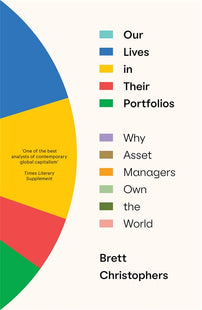The Age of Asset Management
Brett Christophers examines our new financial masters: asset managers.

The business of capitalist asset management has existed in one form or another for as long as private-property rights, surpluses of financial wealth and meaningful opportunities for wealth investment have coexisted. Among the holders of wealth surpluses, there have always been corporations and individuals keen not to handle investment of those surpluses themselves, but rather to outsource such activity to expert, professional managers.
Investment managers referred to as trusts were already an institutional fixture in the City of London by the mid nineteenth century, for instance. Nevertheless, it would be another century before anything resembling the modern asset-management industry began to take shape. And it was not until the beginning of the 1980s that that industry began to enjoy significant growth: precise consolidated figures for that period are not readily available, but global AUM – which, as we have seen, breached $100 trillion in 2020 – probably amounted to not much more than $100 billion (one-thousandth of the 2020 sum) four decades previously. The subsequent growth has had two basic drivers. Total global financial wealth has increased dramatically; so also has the proportion of that wealth invested via asset managers.
The first area of the mushrooming asset-management business to receive meaningful critical attention in terms of its implications for wider society was, interestingly, a relatively small business niche: private equity. The label ‘private equity’ is often used to signify a type of business – Carlyle Group is a private-equity firm, people will say – but it is more accurately applied to a type of asset, or what is commonly referred to as a particular ‘asset class’. Private equity, in short, is one of the various things that asset managers can and do invest in – specifically, equity (company shares) that is not traded on public exchanges, as distinct from tradeable ‘public equity’, such as shares in Apple or Amazon.
What people call private-equity firms, then, are in fact better understood as asset managers that happen to invest mainly or exclusively in the private-equity asset class. Though the value of AUM invested in private equity was (and remains) much smaller than AUM channelled into publicly traded equity and debt securities via vehicles such as mutual funds, it was nonetheless private equity that predominantly caught critics’ eyes in the 1980s and 1990s. This was unsurprising: in its most high-profile, publicly visible form, asset managers’ private-equity investment activity involved hostile takeover bids and the use of copious amounts of debt (the term ‘leveraged buyout’ was widely preferred), and often resulted in asset-stripping and large numbers of redundancies at acquired firms. This was a world away from the dry fare of most asset-management business practice.
The standard-setter among critiques of private equity was Bryan Burrough and John Helyar’s best-selling 1990 book Barbarians at the Gate, subsequently made into a television movie. The ‘barbarians’ in question were the asset-management firm Kohlberg Kravis Roberts, today known simply as KKR & Co. Founded in 1976, in 1988 KKR completed the deal chronicled in Barbarians at the Gate. This was the bitterly contested $25 billion acquisition of the US tobacco and food-product conglomerate RJR Nabisco – by far the largest leveraged buyout in history to that point.
For private equity, the global financial crisis of 2007–09 was a key moment. Until then, banks, and especially investment banks, had been widely regarded as the dominant, most powerful players in the world of global finance. But banks were now widely held responsible for the crisis, and – in Western nations, at least – they had their wings clipped by regulators as a result. As big banks became ‘more heavily regulated and scrutinized’, a Bloomberg report later observed, private-equity firms moved forcefully out of their shadow: ‘Almost everything that’s happened since 2008 has tilted in [private equity’s] favor.
Low interest rates to finance deals? Check. A friendly political climate? Check. A long line of clients? Check … Private equity managers’, the report concluded, ‘won the financial crisis.’ But it was not just private-equity-focused managers who ‘won’ the financial crisis: this was also true of asset managers more generally. From some $46 trillion in 2008, global AUM leapt to $74 trillion six years later, on which the industry earned annual net revenues of approximately $260 billion. Not only that, but the burgeoning business of asset management was proving immensely profitable – ‘among the world’s most profitable businesses’, as the authors of a Boston Consulting Group analysis put it.
By the mid 2010s, then, commentators were unanimous that global finance had seen nothing less than a deep-seated structural shift. Being increasingly ‘risk-averse’, banks, intimated Landon Thomas in the New York Times, were yesterday’s news. Amid ‘super-low interest rates’, the balance of power on Wall Street had instead shifted decisively towards institutions with bigger risk appetites – in particular, towards ‘asset managers, which have been inundated with cash from investors desperate for higher returns’. Little wonder that, so as not to lose sight of their ascendant rivals, global investment banks increasingly ploughed resources precisely into expanding their own asset-management arms. Andrew Haldane, the cerebral Bank of England economist, in a 2014 speech at the London Business School, perhaps captured the mood best. After – and as a result of – the financial crisis, he surmised, we had finally arrived in ‘the age of asset management’.
— An edited excerpt from Our Lives in Their Portfolios: Why Asset Managers Own the World by Brett Christophers
[book-strip index="1" style="buy"]

